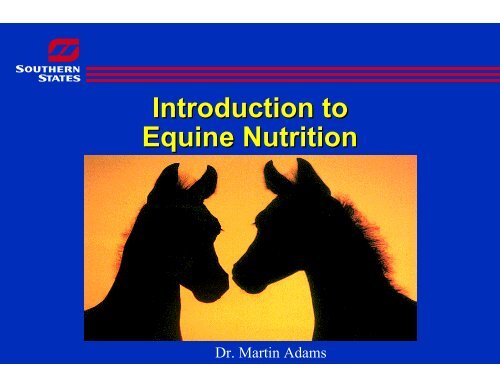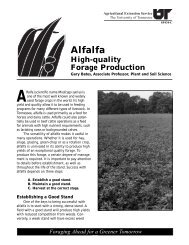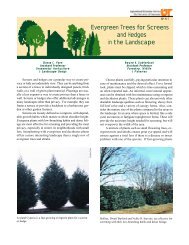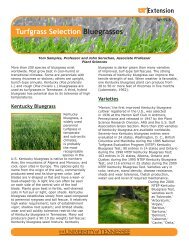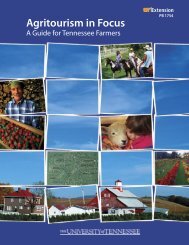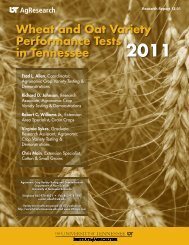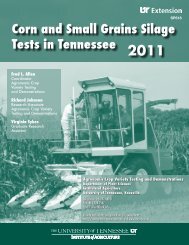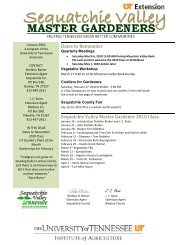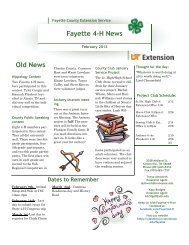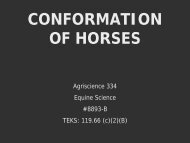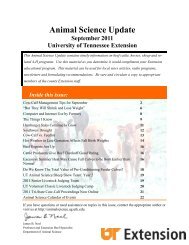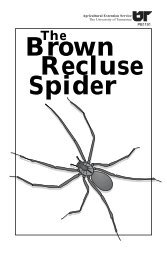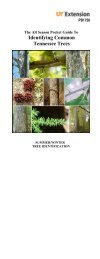Intro to Equine Nutrition - UT Extension
Intro to Equine Nutrition - UT Extension
Intro to Equine Nutrition - UT Extension
You also want an ePaper? Increase the reach of your titles
YUMPU automatically turns print PDFs into web optimized ePapers that Google loves.
<strong>Intro</strong>duction <strong>to</strong><br />
<strong>Equine</strong> <strong>Nutrition</strong><br />
Dr. Martin Adams
Annual Cost of<br />
Horse Ownership<br />
<strong>Nutrition</strong> $1,200<br />
Health Care $600<br />
Hoof Care $450<br />
Other $750<br />
Total $3,000
Horse Years versus Human Years<br />
• First four horse years = 6.5 human years each<br />
• Subsequent horse years = 2.5 human years each<br />
• 1 human year = 6.5 horse years<br />
• 2 human years = 13 horse years<br />
• 5 human years = 28.5 horse years<br />
• 15 human years = 53.5 horse years<br />
• 24 human years = 76 horse years<br />
• 30 human years = 91 horse years
Dietary Requirements<br />
of the Horse<br />
• Water - most important nutrient<br />
• Energy - carbohydrate, fat and protein<br />
• Fat - vegetable oil and animal fat<br />
• Protein - plant and animal sources<br />
• Minerals - major and minor<br />
• Vitamins - fat-soluble and water-soluble<br />
• Forage - hay and pasture
Water<br />
• Horse can survive only 5 days without water but 25<br />
days without feed<br />
• Best water intake occurs at 45-65° F<br />
• Salt, electrolyte and excessive protein consumption<br />
increases water intake<br />
• Restriction leads <strong>to</strong> dehydration, inability <strong>to</strong> sweat,<br />
impaction colic, decreased work (4%), death (15%)
Water<br />
• Needed for all body functions: digestion, waste<br />
elimination, body temperature regulation<br />
• Requirement depends on size, metabolic status,<br />
activity, environment, diet<br />
• Normal maintenance needs are 1 gallon/100 lbs.<br />
BW/day, performance or lactating horses need 15-<br />
40 gallons/day
Energy<br />
• Not a nutrient, estimated from animal studies<br />
• Measured in kiloalories (Kcal) or megacalories<br />
(Mcal) of digestible energy (DE)<br />
• Excess energy (or grain) results in:<br />
– DOD (Developmental Orthopedic Disease)<br />
– Colic - Founder - Laminitis<br />
– Obesity - Reduced Performance
Energy<br />
• Provides fuel for maintenance, growth, pregnancy,<br />
lactation, work<br />
• Lack of energy results in:<br />
– Reduced growth<br />
– Weight loss<br />
– Lack of stamina or reduced performance<br />
– Underweight foals<br />
– Reduced milk production<br />
– Decreased conception rate
Calories<br />
• calorie (cal) = amount of heat required <strong>to</strong> heat<br />
1 g of water 1º Celsius<br />
• Calorie or Kcal = 1,000 calories<br />
• Mcal = 1,000,000 calories or 1,000 kcal<br />
• 1 Mcal = 1,000 Kcal = 1,000,000 cal
Digestible Energy (DE)<br />
Requirements for Maintenance<br />
Body Weight<br />
800<br />
900<br />
1000<br />
1100<br />
1200<br />
DE (Mcal)<br />
12.3<br />
13.6<br />
15.0<br />
16.4<br />
17.0
Digestible Energy (DE)<br />
Requirements for Work<br />
• Light Work - Maintenance DE x 1.25<br />
– pleasure, hunter/hack, trail riding<br />
• Moderate Work - Maintenance DE x 1.5<br />
– cutting, barrel racing, jumping, reining<br />
• Intense Work - Maintenance DE x 2.0<br />
– race training, polo, eventing
Carbohydrates<br />
• Major source of energy in diet<br />
• Non-structural - plant cell contents - sugars and<br />
starches - broken down in small intestine in<strong>to</strong><br />
glucose<br />
• Structural - fiber - plant wall - cellulose and<br />
hemicellulose - fermented in large intestine in<strong>to</strong><br />
glucose and other sugars<br />
• Roughages - high fiber, low starch, low DE<br />
• Grains - low fiber, high starch, high DE
Fat<br />
• Source of essential fatty acids (EFA) needed for<br />
hormones and cell membranes - linolenic acid<br />
(omega-3) and linoleic acid (omega-6)<br />
• Contains more calories per unit (2.25X) than<br />
carbohydrates or protein, high energy density<br />
• Unsaturated fats improve skin and hair condition,<br />
helps hair shedding and “bloom”<br />
• High fat diets improve short-term and long-term<br />
performance
Digestible Energy Content of<br />
4500<br />
4000<br />
3500<br />
3000<br />
2500<br />
2000<br />
1500<br />
1000<br />
500<br />
0<br />
Feed Ingredients (kcal/lb)<br />
Peanut Hulls<br />
Grass Hay<br />
Alfalfa Hay<br />
Beet Pulp<br />
Soybean Hulls<br />
Oats<br />
Barley<br />
Corn<br />
Rice Bran<br />
Vegetable Oil
Examples of Collective Feed<br />
Ingredients for Roughage Products<br />
Good Quality Sources:<br />
• Beet Pulp<br />
• Soybean Hulls<br />
• Dried Citrus Pulp<br />
• Dried Apple Pectin Pulp<br />
• Alfalfa Meal<br />
Poor Quality Sources:<br />
• Peanut Hulls<br />
• Oat Hulls<br />
• Ground Straw<br />
• Cot<strong>to</strong>nseed Hulls<br />
• Rice Hulls<br />
• Rice Mill Feed
Selection of Horse Feed<br />
• Collective terms - least cost formula that can<br />
change ingredients<br />
• Collective terms hide “low calorie” roughage<br />
product ingredients<br />
• Fixed formulas - no collective terms, lists<br />
specific ingredients<br />
• Choose one with no “low calorie” roughage<br />
products
Protein<br />
• Composed of essential and nonessential amino<br />
acids<br />
• Needed for growth in young horses, fetal tissue<br />
development, milk protein synthesis, body tissue<br />
repair<br />
• Major component of muscle, skin, hair, hooves,<br />
ligaments, bone, enzymes, hormones<br />
• Inadequate protein or lysine will limit growth
Dietary Protein Requirements<br />
• Nursing Foal: 16%<br />
• Weanling: 13%<br />
• Yearling: 11.3%<br />
• Long Yearling: 10.1%<br />
• Long Yearling (training): 10.8%<br />
• Mature Horse (no work): 7.2%<br />
• Mature Horse (light work): 8.8%<br />
of Horses (as fed basis)<br />
• Mature Horse (mod. work): 9.4%<br />
• Mature Horse (intense work): 10.3%<br />
• Stallion (breeding): 8.6%<br />
• Pregnant Mare (1st 9, 8-9, 11 mos.): 8.9%,<br />
9.0%, 9.5%<br />
• Nursing Mare (1st 3, 2nd 3 mos.):<br />
12%, 10%
Minerals<br />
• Needed for bone and teeth development, blood<br />
formation, electrolyte balance, fetal development,<br />
reproductive function, milk production<br />
• Macrominerals - calcium, phosphorus, potassium,<br />
sodium, chloride, magnesium, sulfur<br />
• Microminerals - copper, zinc, cobalt, iodine, iron,<br />
manganese, selenium
Vitamins<br />
• Necessary for many metabolic reactions in body,<br />
especially involving energy metabolism<br />
• Fat soluble - A, D, E and K<br />
• Water soluble - B vitamins and C<br />
• Requirements affected by age, activity level, health,<br />
diet<br />
• B vitamins and K synthesized in hindgut<br />
• Toxicity most likely with vitamins A and D
Digestive System of Horse<br />
• Mouth<br />
• Esophagus (4-5 ft.)<br />
• S<strong>to</strong>mach (8-10 qt.)<br />
• Small Intestine (70 ft., 68 qt.)<br />
– Duodenum, Jejunum, Ileum<br />
• Large Intestine (26 ft., 134 qt.)<br />
– Cecum, Large Colon, Small Colon, Rectum
Digestive Capacity of GI Tract<br />
Large Colon<br />
38%<br />
Small Colon<br />
9%<br />
S<strong>to</strong>mach<br />
8%<br />
Cecum<br />
15%<br />
Small Intestine<br />
30%
<strong>Equine</strong> Nutrient Digestion<br />
• Monogastric herbivore - simple s<strong>to</strong>mach, eats plants<br />
• Hindgut fermenter - digestion of fiber in LI<br />
• Digestion and absorption of nonfibrous feed ingredients<br />
(protein, fat, sugar, starch, water, vitamins, minerals) in<br />
s<strong>to</strong>mach and SI - FOREG<strong>UT</strong><br />
• Digestion and fermentation of fibrous feed ingredients<br />
(cellulose and hemicellulose) in cecum and large colon by<br />
bacteria and absorption of VFA, water, ammonia, minerals,<br />
vitamins - HINDG<strong>UT</strong>
Digestive Capacity of Foregut<br />
Hindgut<br />
62%<br />
and Hindgut<br />
Foregut<br />
38%
Forage<br />
• Baled hay, hay cubes, chopped hay and pasture<br />
(long-stemmed fiber, 1-1.5 inch min. length) - grass,<br />
legume, and mixed<br />
• Needed for proper digestive function<br />
• Inadequate roughage can lead <strong>to</strong> cribbing, mane<br />
and tail chewing, manure consumption<br />
• Feed 1-1.5% of body weight daily<br />
• Poor quality increases risk of impaction colic
Hay Selection<br />
• Fresh smell - free of dust and mold<br />
• Leafy - high leaf <strong>to</strong> stem ratio<br />
• Clean - free of weeds, dirt, trash, mold<br />
• Color - bright green (short s<strong>to</strong>rage time)<br />
• Maximum 42% ADF (dry matter basis)<br />
• 8-14% crude protein
Pasture Management<br />
• S<strong>to</strong>cking rate is 2 acres per horse<br />
• Overgrazing leads <strong>to</strong> pasture destruction and weed<br />
establishment<br />
• Use soil analysis <strong>to</strong> determine fertilizer needs<br />
• Weed control measures include grazing<br />
management, mowing and herbicides<br />
• Don’t graze under 4 inches, graze at 4 <strong>to</strong> 8 inches,<br />
mow/clip at 12 inches
Recommended Daily Grain and<br />
Forage Levels for Horses (% BW)<br />
Class Grain Forage<br />
Maintenance 0-0.5 1.5-2.0<br />
Light Work 0.5-0.75 1.0-1.5<br />
Moderate Work 0.75-1.0 1.0-1.5<br />
Intense Work 1.0-1.5 1.0-1.5
Recommended Daily Grain and<br />
Forage Levels for Horses (% BW)<br />
Class Grain Forage<br />
Pregnant Mare 0.5-1.0 1.5-1.5<br />
Lactation-Early 1.0-1.5 1.0-1.5<br />
Nursing Foal 0.5 Free-Choice<br />
Weanling 1.0-1.5 1-1.5<br />
Yearling 0.5-1.0 1.0-1.5
Complete Feeding Program<br />
• Water<br />
• Forage (hay, hay cubes, chopped hay, pasture)<br />
• Feed (grain or concentrate) - provides balance of nutrients<br />
• Mineral/Vitamin Supplement (balances mineral and vitamin<br />
levels of forage)<br />
• Most horses unable <strong>to</strong> maintain body weight on all-forage<br />
diet, energy density <strong>to</strong>o low, maximum feed intake is 2.5-<br />
3.0% BW
Types of Horse Feed<br />
• Sweet or Textured - consist of whole or processed<br />
grains mixed with molasses, some ingredients may<br />
be pelleted<br />
• Pelleted - ingredients are ground, mixed, heated<br />
with steam and forced through a die<br />
• Extruded - ingredients are ground, mixed, pressurecooked<br />
and forced through a die<br />
• Complete - fed as sole diet, 12-30% crude fiber,<br />
pellets and cubes
Densities of Different Feeds<br />
Wheat Bran<br />
Beet Pulp<br />
Whole Oats<br />
Sweet Feed<br />
Pelleted Feed<br />
Whole Corn<br />
Pounds/Quart<br />
0.5<br />
0.6<br />
1.0<br />
1.4<br />
1.6<br />
1.7
Feed Additives<br />
• Probiotics - beneficial bacteria in gut, reduced diarrhea, increased feed<br />
efficiency<br />
• Yeast culture - increased fiber and protein digestion, greater phosphorus<br />
absorption<br />
• Organic/chelated/proteinated minerals- greater absorption for faster growth<br />
rate, increased conception rate, improved immune response and faster<br />
hoof growth<br />
• Vegetable oil - source of EFA, improved coat condition, greater hoof<br />
flexibility and less cracking<br />
• Digestive enzymes - derived from fungal culture that breakdown starch,<br />
protein and fat<br />
• Yucca schidigera - plant compound that binds ammonia in blood and<br />
manure<br />
• MTB-100 - myco<strong>to</strong>xin binder<br />
• Bio-Mos - bacteria binder
Body Condition Scoring<br />
• 1-3 Poor - Thin<br />
• 4 Can see ribs, vertebral ridge evident<br />
• 5 Back flat, can’t see ribs, but can feel them<br />
• 6 Crease down back, fat deposits<br />
• 7-9 Fleshy - Extremely fat
Feeding Example for 1100-lb. 1100 lb.<br />
Horse at Light Work<br />
• DE Required - 20.5 Mcal per day<br />
• Available Hay - 10% protein and 0.85 Mcal/lb DE<br />
• Feeding 14 pounds daily of hay - provides 12 Mcal DE<br />
• Need <strong>to</strong> feed:<br />
• 5 pounds of Triple Crown 10 or<br />
(10% protein, 10% fat, 1.7 Mcal/lb DE)<br />
• 5.7 pounds of Legends 10 or<br />
(10% protein, 6% fat, 1.5 Mcal/lb DE)<br />
• 6.4 pounds of Reliance 10<br />
(10% protein, 3% fat, 1.35 Mcal/lb DE)
Feeding Example for 1100-lb. 1100 lb.<br />
Horse at Moderate Work<br />
• DE Required - 24.6 Mcal per day<br />
• Available Hay - 10% protein and 0.85 Mcal/lb DE<br />
• Feeding 14 pounds daily of hay - provides 12 Mcal DE<br />
• Need <strong>to</strong> feed:<br />
• 7.4 pounds of Triple Crown 10 or<br />
(10% protein, 10% fat, 1.7 Mcal/lb DE)<br />
• 8.4 pounds of Legends 10 or<br />
(10% protein, 6% fat, 1.5 Mcal/lb DE)<br />
• 9.3 pounds of Reliance 10<br />
(10% protein, 3% fat, 1.35 Mcal/lb DE)
Feeding Example for 1100-lb. 1100 lb.<br />
Horse at Intense Work<br />
• DE Required - 32.8 Mcal per day<br />
• Available Hay - 10% protein and 0.85 Mcal/lb DE<br />
• Feeding 14 pounds daily of hay - provides 12 Mcal DE<br />
• Need <strong>to</strong> feed:<br />
• 12.2 pounds of Triple Crown 10 or<br />
(10% protein, 10% fat, 1.7 Mcal/lb DE)<br />
• 13.9 pounds of Legends 10 or<br />
(10% protein, 6% fat, 1.5 Mcal/lb DE)<br />
• 15.4 pounds of Reliance 10<br />
(10% protein, 3% fat, 1.35 Mcal/lb DE)
Feeding Guidelines<br />
• Feed horses individually and observe for<br />
abnormal eating behavior<br />
• Maintain constant growth rates and body weight:<br />
use weight tapes or body condition scoring on<br />
monthly basis<br />
• Have clean fresh water, 45-65º F, available at all<br />
times
Feeding Guidelines<br />
• Feed at regular intervals, 2X <strong>to</strong> 3X daily, no more<br />
than 0.5% of body weight per feeding (5 lbs. for<br />
1,000 lb. horse)<br />
• Prevent rapid consumption of large amounts of<br />
grain - slow down eating rate<br />
• Feed by weight and not by volume: know the<br />
weight of hay and grain fed<br />
• Don’t increase grain > 1 lb. per day
Feeding Guidelines<br />
• Feed good quality hay (max. 42% ADF on DM<br />
basis, free of weeds, mold and dust) or other<br />
forage at min. 1% BW daily<br />
• For “complete” feeds (Senior, Complete, High<br />
Fiber, Maturity, Racing Formula, Low Starch,<br />
Growth) feed min. 0.5% BW daily in forage<br />
• Follow grain feeding directions for body weight,<br />
class, activity and forage type
Feeding Guidelines<br />
• S<strong>to</strong>re feed in cool, dry area, off the ground,<br />
protected from insects/rodents<br />
• Make all feed changes (hay and grain) gradually,<br />
over a 7-10 day period<br />
• Follow sound parasite control, vaccination &<br />
dentistry programs<br />
• Use high fat feed or fat supplement for hard<br />
keepers
Feeding Guidelines<br />
• Provide free-choice access <strong>to</strong> mineral<br />
supplement (EquiMin)<br />
• Provide daily exercise or turnout, prevent 24hour<br />
stall confinement<br />
• For easy keepers or overweight horses<br />
(feeding < 0.5% of body wt. daily) use a<br />
concentrated supplement (Triple Crown Lite)
Triple Crown Horse Feeds<br />
• Premium ingredients<br />
• High fat - 5 feeds with 10% fat<br />
• For maintenance, breeding, growth,<br />
lactation and performance needs<br />
• Equimix technology<br />
– Yeast culture<br />
– Organic trace minerals<br />
– Probiotics<br />
– Flax seed<br />
– Digestive enzymes<br />
– Yucca extract<br />
– Bio-Mos<br />
– MTB-100<br />
– Kelp meal<br />
– Rice bran
Legends Horse Feeds<br />
• 10%, 12%, 14% and 16%<br />
protein levels<br />
• For maintenance, breeding,<br />
growth, lactation and<br />
performance needs<br />
• Textured and pelleted fixed<br />
formulas<br />
• 6% & 10% fat levels<br />
• Yeast culture<br />
• Lysine and biotin<br />
• Organic minerals
Reliance Horse Feeds<br />
• 10% and 12% protein<br />
levels<br />
• 3% fat<br />
• No fillers<br />
• Textured and pelleted<br />
fixed formulas<br />
• Meets maintenance<br />
and light work needs


